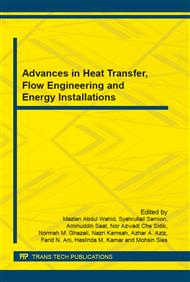p.34
p.42
p.46
p.58
p.63
p.69
p.74
p.78
p.83
Effects of the Optimized Resonator Dimensions on the Performance of the Standing-Wave Thermoacoustic Refrigerator
Abstract:
Thermoacoustic refrigerator is an alternative cooling system, which is environmentally safe due to the absence of any refrigerants. The resonator tube of the system is of great importance; its design and dimensions influence the design and performance of the entire refrigerator. This work describes the design of the stack and the resonator along with the influence of its dimensions on the performance of the standing-wave thermoacoustic refrigerator. The resonator consists of two tubes, one larger than the other, characterized by the diameter ratio of the smaller over the larger diameter. A Lagrange multiplier method is used as a technique to optimize the coefficient of performance (COP) of the system. Results show that the resonator small diameter tube dissipates a minimum acoustic power at a diameter ratio of 0.46, which is 17 percent less than the published values. Moreover, the results show that the resonator length increases gradually with the increase of the mean design temperature which leads to the increase of the total acoustic power dissipated by the resonator, reducing the COP of the standing-wave thermoacoustic refrigerator.
Info:
Periodical:
Pages:
63-68
Citation:
Online since:
January 2016
Price:
Сopyright:
© 2016 Trans Tech Publications Ltd. All Rights Reserved
Share:
Citation:


